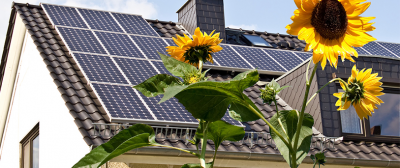Monocrystalline vs Polycrystalline Solar Panels

Should you choose monocrystalline or polycrystalline solar panels for your home? Here we explore the key differences between the two main types of solar panels to help you decide.
Choosing solar panels for your home can be a daunting task at first, not only because you want to ensure you invest in a quality and reliable brand of solar panel, but also because there are often multiple choices within each brand’s product range. This is due to the fact that there are two main types of solar PV panel: monocrystalline (mono) and polycrystalline (poly).
Both mono and poly solar panels will convert energy from the sun into usable electricity for your home, but there are some differences between the types of solar panels.
Get FREE Solar Panel Quotes
Monocrystalline vs polycrystalline: what’s the difference?
Both monocrystalline and polycrystalline solar panels will generate free and clean electricity for your home using energy from the sun. Both types will do this very efficiently, but there are some differences between the two.
The difference between monocrystalline and polycrystalline solar panels lies in the silicon cells used in their production. Monocrystalline solar panels are made of single crystal silicon whereas polycrystalline solar panels are made of up solar cells with lots of silicon fragments melted together. In terms of visual difference, monocrystalline panels are black while polycrystalline are dark blue.
Monocrystalline solar panels
Monocrystalline solar panels are regarded as the higher quality product as they tend to deliver a higher level of efficiency, i.e. they can produce more electricity than polycrystalline. They are also sleeker in design and therefore, arguably, more aesthetically pleasing.
In order to produce monocrystalline solar panels the silicon is formed into bars before being cut into wafers. The cells are made of single-crystal silicon which means that the electrons have more space to move around and can therefore generate more energy. However, because the panels are more efficient, they are usually more expensive than polycrystalline.
Polycrystalline solar panels
Polycrystalline (also known as multicrystalline or many-crystalline) solar panels are generally cheaper because they are less efficient. These panels are made of lots of silicon crystals which have been melted together to form a cell. Because of the high number of crystals per cell, the electrons do not have as much space to move and therefore produce less energy. They are usually blue in colour which can mean they stand out more on a roof.
Monocrystalline vs. polycrystalline solar panels: which panels are right for you?
One of the main motivations behind installing solar panels is often to reduce electricity bills. By generating your own free electricity supply you can buy less from your supplier and reduce your dependence on the grid. Whether you choose monocrystalline or polycrystalline, you will be able to reduce your electricity costs.
Efficiency
Monocrystalline panels are more efficient reaching efficiencies between 15-20% on average while polycrystalline panels are only 13-16% efficient. For this reason, if maximising electricity generation and reducing costs is a priority, monocrystalline are likely to be slightly more effective.
Colour preference
While it may not be a major consideration for everyone, some people may have a preference in terms of the the colour of the panels. Monocrystalline panels are black or at least much darker in colour than polycrystalline which are blue in colour.
Space restrictions
If you have a small roof then the efficiency of your solar panels should be a major consideration. Properties with small roofs should opt for monocrystalline solar panels which will maximise electricity production. However, properties which do not have the same space restrictions, buying a higher number of polycrystalline panels may be more cost effective.
Get FREE Solar Panel Quotes
What power output do you need?
Solar panels are given a power output rating which is measured in watts (W). The majority of solar panels have power outputs between 250-360 W although they can reach 400 W. In order to determine what power output you need, you should look at recent electricity bills to determine how much electricity your household uses during a given period.
| House Type | 年平均用电量(度) | Average Daily Electricity Usage (kWh) |
| Mid Terrace | 2,779 | 7.6 |
| Flat | 2,829 | 7.7 |
| End Terrace | 3,442 | 9.4 |
| Semi Detached | 3,847 | 10.5 |
| Bungalow | 3,866 | 10.6 |
| Detached | 4,153 | 11.3 |
On average, the typical UK household uses 8-10 kWh of electricity per day, but this will obviously vary depending on the size of the property and the number of inhabitants. A 250 W solar panel could generate 1,125 watts per hour (Wh) with 4 hours of direct sunlight. To meet the electricity demands of an average home, more than one panel would be required which is known as a solar panel array or solar panel system.
How many solar panels do you need?
The majority of solar panels arrays in the UK are sized between 1-4 W kW which are made up of between 2-16 panels. To determine how many solar panels to install, you need to determine how much electricity you use each day, how much power the panels can produce and how much sunlight your roof will be exposed to (on an average day).
On average, a UK home receives 4.5 hours of direct sunlight each day, although this is impacted by cloudy weather and will increase/decrease depending on the season. To work out how much electricity a solar panel will generate for your home we need to multiply the number of sunshine hours by the power output of the solar panel.
For example, in the case of a 300 W solar panel, we would calculate 4.5 x 300 (sunlight hours x power output) which equals 1,350 watt-hours (Wh) or 1.35 kWh. If we then divide this figure by your average daily electricity usage you can determine approximately how many solar panels you need.
| Average Daily Electricity Usage (kWh) | Number of 240 watt solar panels | Number of 300 watt solar panels | Number of 400 watt solar panels | |
| Mid Terrace | 7.6 | 7 | 6 | 4 |
| Flat | 7.7 | 7 | 6 | 4 |
| End Terrace | 9.4 | 9 | 7 | 5 |
| Semi Detached | 10.5 | 10 | 8 | 6 |
| Bungalow | 10.6 | 10 | 8 | 6 |
| Detached | 11.3 | 10 | 8 | 6 |
This table shows the number of panels required if you want a solar array to meet your home’s total electricity consumption. If you only want solar panels to cover some or most of your electricity consumption, you can install fewer solar panels.
Get quotes for solar panels
在你面前make a final decision between monocrystalline vs polycrystalline solar panels it is important to seek advice from a professional solar installer. They will be able to assess your home’s size and electricity consumption before recommending the best size and type of solar panel system for your home.
Take a few moments to complete our simple online form and you can get free quotes from up to 3 MCS or equivalent solar panel installers based in your local area. Comparing multiple quotes will give you a much greater chance of finding the most competitive price for a solar panel installation where you live.













